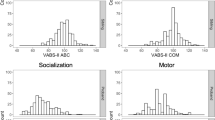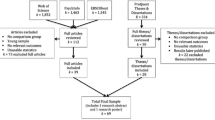Abstract
Later-born siblings of children with autism spectrum disorder (Sibs-ASD) are at elevated risk for social impairments. Two putative predictors of later social impairment—measures of responding to joint attention and weighted triadic communication—were examined in a sample of 43 Sibs-ASD who were followed from 15 to 34 months of age. Results revealed that initial level of responding to joint attention and growth rate of weighted triadic communication predicted the degree of social impairment at the final measurement period. Additionally, both predictors were associated with later ASD diagnosis. In contrast, unweighted triadic communication, age of entry into the study, and initial language level did not predict later social impairment. The importance of considering social outcome as a continuous variable in prospective studies of Sibs-ASD is discussed.


Similar content being viewed by others
References
American Psychiatric Association. (2000). Diagnostic and statistical manual of mental disorders-iv-text revision (4 th ed., rev.). Washington, DC: American Psychiatric Association.
Bailey, A., Palferman, S., Heavey, L., & Le Couteur, A. (1998). Autism: The phenotype in relatives. Journal of Autism and Developmental Disorders, 28, 369–392. doi:10.1023/A:1026048320785.
Baron-Cohen, S. (2002). The extreme male brain theory of autism. Trends in Cognitive Sciences, 6, 248–254. doi:10.1016/S1364-6613(02)01904-6.
Baron-Cohen, S., & Belmonte, M. K. (2005). Autism: A window onto the development of the social and the analytic brain. Annual Review of Neuroscience, 28, 109–126. doi:10.1146/annurev.neuro.27.070203.144137.
Beakley, B., & Ludlow, P. (1992). The philosophy of the mind: Classical problems/contemporary issues. Cambridge, MA: The MIT Press.
Bolton, P., Macdonald, H., Pickles, A., Rios, P., Goode, S., Crowson, M., et al. (1994). A case-control family history study of autism. Journal of Child Psychology and Psychiatry and Allied Disciplines, 35, 877–900. doi:10.1111/j.1469-7610.1994.tb02300.x.
Cassel, T. D., Messinger, D. S., Ibanez, L. V., Haltigan, J. D., Acosta, S. I., & Buchman, A. C. (2007). Early social and emotional communication in the infant siblings of children with autism spectrum disorders: An examination of the broad phenotype. Journal of Autism and Developmental Disorders, 37, 122–132. doi:10.1007/s10803-006-0337-1.
Constantino, J. N., Lajonchere, C., Lutz, M., Gray, T., Abbacchi, A., McKenna, K., et al. (2006). Autistic social impairment in the siblings of children with pervasive developmental disorders. The American Journal of Psychiatry, 163, 294–296. doi:10.1176/appi.ajp.163.2.294.
Constantino, J. N., Pryzbeck, T., Friesen, D., & Todd, R. D. (2000). Reciprocal social behavior in children with and without pervasive developmental disorders. Journal of Developmental and Behavioral Pediatrics, 21, 2–11. doi:10.1097/00004703-200002000-00001.
Deak, G. O., Walden, T., Kaiser, M. G., & Lewis, A. (2008). Driven from distraction: How infants respond to parents’ attempts to elicit and re-direct their attention. Infant Behavior and Development, 31, 34–50. doi:10.1016/j.infbeh.2007.06.004.
Goldberg, W. A., Jarvis, K. L., Osann, K., Laulhere, T. M., Straub, C., Thomas, E., et al. (2005). Brief report: Early social communication behaviors in the younger siblings of children with autism. Journal of Autism and Developmental Disorders, 35, 657–664. doi:10.1007/s10803-005-0009-6.
Gotham, K., Risi, S., Dawson, G., Tager-Flusberg, H., Joseph, R., Carter, A., et al. (2008). A replication of the autism diagnostic observation schedule (ADOS) revised algorithms. Journal of the American Academy of Child and Adolescent Psychiatry, 47, 642–651. doi:10.1097/CHI.0b013e31816bffb7.
Greenwood, C. R., Carta, J. J., Walker, D., Hughes, K., & Weathers, M. (2006). Preliminary investigations of the application of the early communication indicator for infants and toddlers. Journal of Early Intervention, 28, 178–196. doi:10.1177/105381510602800306.
Happe, F., Ronald, A., & Plomin, R. (2006). Time to give up on a single explanation of autism. Nature Neuroscience, 9, 1218–1220. doi:10.1038/nn1770.
Landa, R., & Garrett-Mayer, E. (2006). Development in infants with autism spectrum disorders: A prospective study. Journal of Child Psychology and Psychiatry and Allied Disciplines, 47, 629–638. doi:10.1111/j.1469-7610.2006.01531.x.
Lord, C., Risi, S., Lambrecht, L., Cook, E. H., Jr, Leventhal, B. L., DiLavore, P. C., et al. (2000). The autism diagnostic observation schedule—generic: A standard measure of social and communication deficits associated with the spectrum of autism. Journal of Autism and Developmental Disorders, 30, 205–223. doi:10.1023/A:1005592401947.
Losh, M., Childress, D., Lam, K., & Piven, J. (2008). Defining key features of the broad autism phenotype: A comparison across parents of multiple- and single-incidence autism families. American Journal of Medical Genetics. Part B, Neuropsychiatric Genetics, 147, 424–433. doi:10.1002/ajmg.b.30612.
McDuffie, A., Yoder, P. J., & Stone, W. L. (2005). Prelinguistic predictors of vocabulary in young children with autism spectrum disorders. Journal of Speech, Language, and Hearing Research: JSLHR, 48, 1080–1097. doi:10.1044/1092-4388(2005/075).
Merin, N., Young, G. S., Ozonoff, S., & Rogers, S. J. (2007). Visual fixation patterns during reciprocal social interaction distinguish a subgroup of 6-month-old infants at-risk for autism from comparison infants. Journal of Autism and Developmental Disorders, 37, 108–121. doi:10.1007/s10803-006-0342-4.
Mitchell, S., Brian, J., Zwaigenbaum, L., et al. (2006). Early language and communication development of infants later diagnosed with autism spectrum disorder. Journal of Developmental and Behavioral Pediatrics, 27, 69–78. doi:10.1097/00004703-200604002-00004.
Morales, M., Mundy, P., Crowson, M., Neal, A. R., & Delgado, C. E. F. (2005). Individual differences in infant attention skills, joint attention, and emotion regulation behavior. International Journal of Behavioral Development, 29, 373–377.
Mullen, E. M. (1995). Mullen scales of early learning. Circle Pines, MN: American Guidance Service.
Mundy, P., Block, J., Van Hecke, A., Delgado, C. E. F., Parlade, M., & Parmares, Y. (2007). Individual differences and the development of joint attention in infancy. Child Development, 78, 705–722. doi:10.1111/j.1467-8624.2007.01042.x.
Mundy, P., Sigman, M., Ungerer, J., & Sherman, T. (1986). Defining the social deficits in autism: The contribution of non-verbal communication measures. Journal of Child Psychology and Psychiatry and Allied Disciplines, 27, 657–669. doi:10.1111/j.1469-7610.1986.tb00190.x.
Pickles, A., Starr, E., Kazak, S., Bolton, P., Papanikolaou, K., Bailey, A., et al. (2000). Variable expression of the autism broader phenotype: Findings from extended pedigrees. Journal of Child Psychology and Psychiatry and Allied Disciplines, 41, 491–502. doi:10.1111/1469-7610.00634.
Piven, J., Palmer, P., Jacobi, D., Childress, D., & Arndt, S. (1997). Broader autism phenotype: Evidence from a family history study of multiple-incidence autism families. The American Journal of Psychiatry, 154, 185–190.
Presmanes, A., Walden, T., Stone, W., & Yoder, P. (2007). Effects of different attentional cues on responding to joint attention in younger siblings of children with autism spectrum disorders. Journal of Autism and Developmental Disorders, 37, 133–144. doi:10.1007/s10803-006-0338-0.
Rutter, M., Le Couteur, A., & Lord, C. (2003). ADI-R: The autism diagnostic interview-revised. Los Angeles, CA: Western Psychological Services.
Sheinkopf, S. J., Mundy, P., Claussen, A., & Willoughby, J. (2004). Infant joint attention skill and preschool behavioral outcomes in at-risk children. Development and Psychopathology, 16, 273–291. doi:10.1017/S0954579404044517.
Sigman, M., & Ruskin, E. (1999). Continuity and change in the social competence of children with autism, Down syndrome, and developmental delays. Monographs of the Society for Research in Child Development, 64(1), v–v114.
Stone, W. L., Coonrod, E. E., & Ousley, O. Y. (2000). Brief report: Screening tool for autism in two-year-olds (STAT): Development and preliminary data. Journal of Autism and Developmental Disorders, 30, 607–612. doi:10.1023/A:1005647629002.
Stone, W. L., Coonrod, E. E., Turner, L. M., & Pozdol, S. (2004). Psychometric properties of the STAT for early autism screening. Journal of Autism and Developmental Disorders, 34, 691–701. doi:10.1007/s10803-004-5289-8.
Stone, W. L., & Lemanek, K. L. (1990). Parental report of social behaviors in autistic preschoolers. Journal of Autism and Developmental Disorders, 20, 513–522. doi:10.1007/BF02216056.
Stone, W. L., McMahon, C., & Henderson, L. M. (2008). Use of the screening tool for autism in two-year-olds (STAT) for children under 24 months: An exploratory study. Autism, 12, 573–589. doi:10.1177/1362361308096403.
Stone, W. L., McMahon, C. R., Yoder, P. J., & Walden, T. A. (2007). Early social-communicative and cognitive development of younger siblings of children with autism spectrum disorders. Archives of Pediatrics and Adolescent Medicine, 161, 384–390. doi:10.1001/archpedi.161.4.384.
Szatmari, P., Jones, M. B., Zwaigenbaum, L., & MacLean, J. E. (1998). Genetics of autism: Overview and new directions. Journal of Autism and Developmental Disorders, 28, 351–368. doi:10.1023/A:1026096203946.
Szatmari, P., MacLean, J. E., Jones, M. B., Bryson, S. E., Zwaigenbaum, L., Bartolucci, G., et al. (2000). The familial aggregation of the lesser variant in biological and nonbiological relatives of PDD probands: A family history study. Journal of Child Psychology and Psychiatry and Allied Disciplines, 41, 579–586. doi:10.1111/1469-7610.00644.
Tapp, J. (2003). ProcoderDV. Nashville, TN: Vanderbilt Kennedy Center.
Turner, L. M., & Stone, W. L. (2007). Variability in outcome for children with an ASD diagnosis at age 2. Journal of Child Psychology and Psychiatry and Allied Disciplines, 48, 793–802. doi:10.1111/j.1469-7610.2007.01744.x.
Van Hecke, A., Mundy, P., Acra, C. F., Block, J., Delgado, C. E. F., Parlade, M., et al. (2007). Infant joint attention, temperament, and social competence in preschool children. Child Development, 78, 53–69. doi:10.1111/j.1467-8624.2007.00985.x.
Wassink, T. H., Brzustowicz, L. M., Bartlett, C. W., & Szatmari, P. (2004). The search for autism disease genes. Mental Retardation and Developmental Disabilities Research Reviews, 10, 272–283. doi:10.1002/mrdd.20041.
Yirmiya, N., Gamliel, I., Pilowsky, T., Feldman, R., Baron-Cohen, S., & Sigman, M. (2006). The development of siblings of children with autism at 4 and 14 months: Social engagement, communication, and cognition. Journal of Child Psychology and Psychiatry and Allied Disciplines, 47, 511–523. doi:10.1111/j.1469-7610.2005.01528.x.
Acknowledgments
We thank the families that participated in this study and the following research staff, graduate students, and clinical staff that made this research possible: Linda Ashford, Eric Esters, Jennifer Foss-Feig, James Kretzer, Justin Lane, Evon Lee, Laura McLean, Caitlin McMahon, Melissa Moss, Joanna Mussey, Ayesha Nasmyth, Anne Osberger, Alison Presmanes, Stacie Pozdol, Amy Swanson, Meredith Townes, Holly Turbeville, Lauren Turner, Teresa Ulman, and Kelly Wendel. This research was supported by grant number R01 HD043292, with additional support from grant numbers P30 HD15052, T32 HD 07226, and the Vanderbilt Kennedy Center Marino Autism Research Institute (MARI). The content is solely the responsibility of the authors and does not necessarily represent the official views of the funding agencies or the National Institutes of Health.
Author information
Authors and Affiliations
Corresponding author
Rights and permissions
About this article
Cite this article
Yoder, P., Stone, W.L., Walden, T. et al. Predicting Social Impairment and ASD Diagnosis in Younger Siblings of Children with Autism Spectrum Disorder. J Autism Dev Disord 39, 1381–1391 (2009). https://doi.org/10.1007/s10803-009-0753-0
Received:
Accepted:
Published:
Issue Date:
DOI: https://doi.org/10.1007/s10803-009-0753-0




